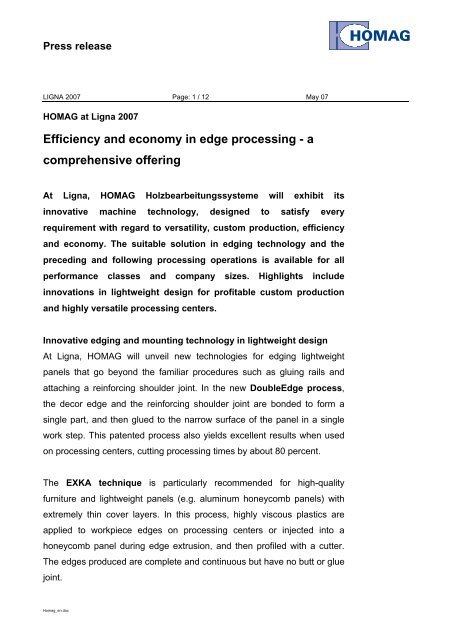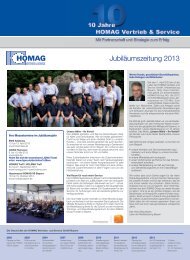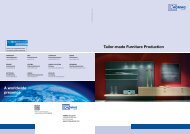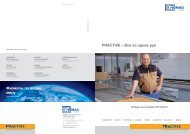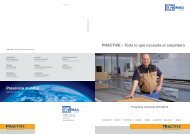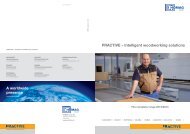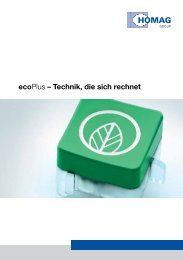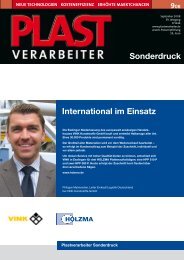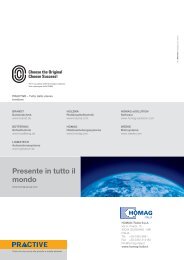Download English - HOMAG Group
Download English - HOMAG Group
Download English - HOMAG Group
You also want an ePaper? Increase the reach of your titles
YUMPU automatically turns print PDFs into web optimized ePapers that Google loves.
Press release<br />
LIGNA 2007 Page: 1 / 12 May 07<br />
<strong>HOMAG</strong> at Ligna 2007<br />
Efficiency and economy in edge processing - a<br />
comprehensive offering<br />
At Ligna, <strong>HOMAG</strong> Holzbearbeitungssysteme will exhibit its<br />
innovative machine technology, designed to satisfy every<br />
requirement with regard to versatility, custom production, efficiency<br />
and economy. The suitable solution in edging technology and the<br />
preceding and following processing operations is available for all<br />
performance classes and company sizes. Highlights include<br />
innovations in lightweight design for profitable custom production<br />
and highly versatile processing centers.<br />
Innovative edging and mounting technology in lightweight design<br />
At Ligna, <strong>HOMAG</strong> will unveil new technologies for edging lightweight<br />
panels that go beyond the familiar procedures such as gluing rails and<br />
attaching a reinforcing shoulder joint. In the new DoubleEdge process,<br />
the decor edge and the reinforcing shoulder joint are bonded to form a<br />
single part, and then glued to the narrow surface of the panel in a single<br />
work step. This patented process also yields excellent results when used<br />
on processing centers, cutting processing times by about 80 percent.<br />
The EXKA technique is particularly recommended for high-quality<br />
furniture and lightweight panels (e.g. aluminum honeycomb panels) with<br />
extremely thin cover layers. In this process, highly viscous plastics are<br />
applied to workpiece edges on processing centers or injected into a<br />
honeycomb panel during edge extrusion, and then profiled with a cutter.<br />
The edges produced are complete and continuous but have no butt or glue<br />
joint.<br />
Homag_en.doc
Press release<br />
LIGNA 2007 Page: 2 / 12 May 07<br />
<strong>HOMAG</strong> will present creative solutions for mounting technology as well in<br />
Hanover. <strong>HOMAG</strong> has been working with Rheinau-based system supplier<br />
Zimmer Kunststoff GmbH to develop a dowel with a drilling diameter of just<br />
8.5 mm that is anchored by purely mechanical means, yet withstands<br />
removal forces up to 700 N. The dowel is splayed in a blind hole in the<br />
bottom cover panel. At the same time, the slotted portion of the dowel<br />
splays under the top cover panel. The dowel is under tension in the hole in<br />
the top cover panel. This forms a joint between the top and bottom<br />
covering layers, which stabilizes the honeycomb panel. This simple<br />
assembly method is ideal for industrial production and can also be<br />
implemented automatically on CNC processing centers reliably and<br />
economically.<br />
Highly variable edge design with print line<br />
Nowadays, edging operations often involve working with over 100 different<br />
decors, designs, and dimensions. <strong>HOMAG</strong> has risen to this challenge, and<br />
in Hanover will demonstrate the innovative print line technique, which is<br />
already being used with great success. In this process, neutral edge<br />
material is printed with an individual decor after it has been applied to the<br />
workpiece. With a feed speed of 20 m/min, workpieces on the print line<br />
system are cleaned and preprocessed, printed, dried, and finally dried<br />
again and painted in one cycle. The system is capable of printing edges up<br />
to a height of 64 mm. A colour management system ensures that colours<br />
and edge decors can be faithfully reproduced.<br />
Compared with conventional edging technology, print line is considerably<br />
less expensive because only one edge type is used for production and<br />
edge decors pass through the process not as a physical flow of materials,<br />
but in the form of information. The significance of this advantage increases<br />
as the order grows smaller. Edges can also be printed with company logos<br />
Homag_en.doc
Press release<br />
LIGNA 2007 Page: 3 / 12 May 07<br />
or individual motifs – for example in shopfitting or booth construction –<br />
which has been prohibitively expensive until now.<br />
Efficient processing center for kitchen countertops<br />
<strong>HOMAG</strong> will showcase the BAZ 523, a highly versatile and powerful<br />
processing center for the most demanding specifications, equipped with<br />
variable clamping and unit technology. The system is designed for use in<br />
panel sizing of shaped parts and kitchen countertop connections. The<br />
processing center is used for edge banding and finish processing in batch<br />
size 1 operations with an enormous variety of decors and geometries. The<br />
gantry construction allows a fast feed speed with excellent accuracy. Work<br />
steps that previously had to be carried out by hand are also automated, so<br />
one employee can operate several machines.<br />
The basic machine includes pre-alignment of the countertop by means of<br />
roller track and lateral stop, and is also equipped with a vacuum/gripper<br />
handling unit for workpiece infeed. An infeed area with trimming unit from<br />
below is available as an option. The innovative portal yokes with doublespindle<br />
technology is fitted with 2 x 18 slot tool changers, a gluing unit, a<br />
new, patented edge cassette system and a PU sealing unit to prevent<br />
moisture from penetrating the bottom surface of the countertop.<br />
Complete edging for workpiece thickness 100 mm<br />
Until now, it has not been possible to completely edge workpieces with a<br />
thickness of 100 mm in a single pass. All that has now changed with<br />
<strong>HOMAG</strong>'s KFL 620 edge banding machine: This machine performs all<br />
edging work steps quickly and reliably, even on thick workpieces. The twosided<br />
system is designed for industrial use and its many possible uses<br />
include narrow surface closure of lightweight panels. And <strong>HOMAG</strong>'s<br />
innovative technology is also available for smaller and midsized<br />
companies in the form of smaller systems and processing centers, so that<br />
Homag_en.doc
Press release<br />
LIGNA 2007 Page: 4 / 12 May 07<br />
they too can reap the benefits of economical edging in lightweight design.<br />
Custom production: economical solutions for all operation sizes<br />
The inexorable trend towards more and more exclusive products is<br />
increasingly affecting the products in smaller and midsize companies.<br />
Especially for this customer group, <strong>HOMAG</strong> presents flex line, an<br />
inexpensive cell concept for economical production of furniture parts in<br />
batch size 1. On a single-sided edge banding machine, workpieces that<br />
have been machined to precise dimensions and angles can be processed<br />
in various sizes. On the new, exceptionally user-friendly entry module<br />
Quick touch, processing steps are selected simply by activating graphical<br />
icons. With a capacity of 12 cycles/min, about 400 workpieces in batch<br />
size 1 can be processed in a production shift, depending on the<br />
dimensions of the workpieces.<br />
The nesting technique was developed for use in single-order production,<br />
and is closely associated with this technique. <strong>HOMAG</strong> offers processing<br />
centers in all performance classes for this. A BOF 612 is a compact<br />
processing center with 2 independent trimming spindles, and has been<br />
specially developed for high-performance processing of complete<br />
unprocessed panels with the nesting technique. Since the two spindles<br />
each work independently on a separate bench, the capacity of the BOF<br />
612 is equal to that of two machines. Parts can be loaded and unloaded<br />
without additional programming thanks to a patented portal feeder.<br />
PRACTIVE: Processing centers with innovative unit technology<br />
The expanded Venture series by <strong>HOMAG</strong> combines five-axis processing<br />
with edge banding. The series includes 18 different machine<br />
configurations to meet the needs of all operation sizes, output quantities<br />
and workpiece sizes. The ability to combine several work steps in one<br />
system is particularly beneficial for small and midsize companies, as it<br />
Homag_en.doc
Press release<br />
LIGNA 2007 Page: 5 / 12 May 07<br />
represents considerable time savings compared with conventional<br />
production methods. All models in the series are equipped with a powerful<br />
main spindle with interpolating C-axis and drill heads of various<br />
performance classes. The patented Multi Processing Unit (MPU) is an<br />
extremely recent innovation - this combines drilling, sawing and routing<br />
without the need to change tools and can be pivoted through 360 degrees.<br />
The patented electronics interface is also integrated in the main spindle,<br />
enabling the use of a vast range of units and lending exceptional versatility<br />
to the processing centers.<br />
The series can be equipped with five-axis technology so that font faces,<br />
drilling and trimming can be performed at various angles. For example,<br />
with the patented FLEX5 unit the angle can be set automatically via the<br />
<strong>HOMAG</strong> <strong>Group</strong>'s standard programming system woodWOP 5.0. A Venture<br />
16 with the patented DRIVE5+ five-axis spindle can also be provided for<br />
staircase construction. Another configuration variant in the Venture series<br />
is the new EasyEdge gluing unit. With this unit, edges can be applied<br />
automatically and in consistently high quality even to single workpieces<br />
and shaped parts without right angles, such as round tabletops. The<br />
integrated TBA 330 feed system can be used even by smaller operations<br />
to cut expensive operator costs without having to invest a lot of money in<br />
robots or automated workpiece handling systems. The feed unit can be<br />
mounted on the lateral flange of <strong>HOMAG</strong>'s standard processing centers,<br />
and does not need a separate controller.<br />
Inexpensive, high-performance edge banding machine<br />
In order to cut unit costs in the PRACTIVE sector even further, <strong>HOMAG</strong><br />
has developed the KAL 210 edge banding machine – a powerful system<br />
with an attractive cost-efficiency ratio. This machine can perform any task<br />
associated with edging a panel, from thin, roll materials to solid wood<br />
edges, with such accuracy that time-intensive manual postprocessing is<br />
Homag_en.doc
Press release<br />
LIGNA 2007 Page: 6 / 12 May 07<br />
unnecessary.<br />
Specifically, the KAL 210 is equipped with a very powerful jointing unit with<br />
a tool diameter of 125 mm, and two motors, one running in synchronous<br />
and the other in reverse rotation, to ensure a clean cut in the top and<br />
bottom of the panel. A hot melt gluing unit is used for applying glue to the<br />
edge, and the edge material is fed automatically from a magazine<br />
containing two rolls. The modern servo edge feed guarantees that the<br />
edge will be glued to the workpiece with pinpoint accuracy - with little<br />
waste and thrifty use of edge material.<br />
The four-motor profile trimming unit for trimming the top and bottom sides<br />
of the edge with chamfer or radius and for rounding the leading or trailing<br />
edge of the workpiece trims perfectly even at feed speeds up to 20 m/min.<br />
The edges are then smoothed with a profile scraper and a glue joint<br />
scraper removes the last traces of hot melt glue for a premium quality<br />
finish.<br />
Homag_en.doc
Press release<br />
LIGNA 2007 Page: 7 / 12 May 07<br />
Figure 1:<br />
DoubleEdge process for lightweight panels<br />
Figure 2:<br />
EXKA - edge extrusion on lightweight panels<br />
Homag_en.doc
Press release<br />
LIGNA 2007 Page: 8 / 12 May 07<br />
Figure 3:<br />
New connection technology with plastic dowels from Zimmer Kunststoff GmbH<br />
Figure 4:<br />
print line - sample parts<br />
Homag_en.doc
Press release<br />
LIGNA 2007 Page: 9 / 12 May 07<br />
Figure 5:<br />
New KFL 620 for tall workpieces<br />
Figure 6:<br />
flex line - inexpensive solution for batch size 1<br />
Homag_en.doc
Press release<br />
LIGNA 2007 Page: 10 / 12 May 07<br />
Figure 7:<br />
Processing center 612<br />
Figure 8:<br />
Venture 21M - new Venture machine for the PRACTIVE sector<br />
Homag_en.doc
Press release<br />
LIGNA 2007 Page: 11 / 12 May 07<br />
Figure 9:<br />
Multi Processing Unit (MPU) - pivots through 360 degrees<br />
Figure 10:<br />
KAL 210 - new edge banding machine with attractive cost-efficiency ratio<br />
Homag_en.doc
Press release<br />
LIGNA 2007 Page: 12 / 12 May 07<br />
For more information, contact<br />
<strong>HOMAG</strong> Holzbearbeitungssysteme AG<br />
Homagstraße 3-5<br />
72296 SCHOPFLOCH<br />
GERMANY<br />
http://www.homag.de<br />
Gerhard Engelen<br />
Head of Marketing Services<br />
Tel. +49 7443 13-2476<br />
Fax +49 7443 13-8-2476<br />
gerhard.engelen@homag.de<br />
Homag_en.doc


